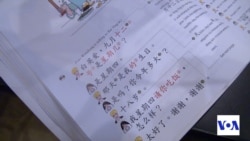"Ni Hao," first responders say as they arrive at an old firehouse in Brooklyn. That's Mandarin Chinese for "hi" or "hello."
About a dozen firefighters, EMTs and paramedics spend about two hours a week taking the first Mandarin course offered under the auspices of the Fire Department of New York's Phoenix Society and the New York City Fire Department Foundation.
A recent U.S. Census Bureau report about New York City revealed an increasingly diverse and dynamic population, with immigrants comprising the majority in some neighborhoods. Almost 200 languages are spoken, so knowledge of different languages can become critical, especially if you are a first responder.
The Chinese community is predicted to become New York's largest immigrant group in the next few years, and will be the largest Chinese community outside of Asia.
Growing need
First responders have to be able to communicate quickly and effectively when an emergency arises, said Lieutenant Steve Lee, president of the FDNY Phoenix Society.
"We're going into these neighborhoods and in these communities and assisting anybody who's in need of such assistance regardless of where they're from," Lee said. "So a lot of times, we do encounter language and barriers. It's a vital resource for us to be able to communicate to the people who are calling for our help."
Discovering the exact location of a blaze without the assistance of a homeowner or renter can be a real handicap, according to Lee.
"So you speak to the people, you say, ‘What building? What's the address? What apartment?' and one of the most important things you can find out, especially if it's an occupant from that apartment, 'Is there anybody left in there and where?'" Lee said.
The statistics underscore the crucial need for multilingual skills. There currently are 450,000 non-English speaking Asians in New York City. On any given day, only six Asian-American firefighters are working the city streets.
Lifelong teacher
Lily Cheung, who teaches the Mandarin class, is thoroughly impressed with this first group of responders.
"I can see this amazing progress they have made with this language, one of the hardest languages in the world,” she said. “They work long hours, some of them actually work the night shift, and they may not even have enough time to rest, but they come to class.”
Cheung started teaching Mandarin when she was 11 years old. Her mother was a Mandarin teacher before she retired.
Cheung has her own style, which she calls the "Chinglish Way."
"I would explain it to them like in the English order," she said. "There's a Chinese order, and then I would translate, like literally dissect the language part-to-part and then combine them together. So just make it really easy for students to understand."
High praise
A paramedic for 14 years, Doraun Ellis has had some Mandarin training before, and has high praise for his teacher.
"She goes to each and every single person in this class," Ellis said, "and goes over the lesson until we thoroughly understand what she's taught. She really shows us how to use it."
Ellis added, "The closer I get to being able to complete an interview with a patient on an emergency call, the more successful I am with making them feel at ease."
The students already have put their language training to use. Jacob Dutton, a 10-year FDNY veteran, responded to an emergency call in the past week involving a report of gas in an apartment.
"We got up there," Dutton said, "and lo and behold, the two occupants of the apartment only spoke Mandarin. And so I did have an opportunity to speak to them and kind of figure out what was going on."
He was able to find the gas leak and get the residents to make the necessary repairs.
A second Mandarin class is scheduled for April, along with classes in other languages.









